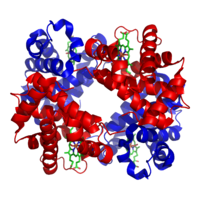
Photo from wikipedia
In humans, fetal erythropoiesis takes place in the liver whereas adult erythropoiesis occurs in the bone marrow. Fetal and adult erythroid cells are not only produced at different sites, but… Click to show full abstract
In humans, fetal erythropoiesis takes place in the liver whereas adult erythropoiesis occurs in the bone marrow. Fetal and adult erythroid cells are not only produced at different sites, but are also distinguished by their respective transcriptional program. In particular, whereas fetal erythroid cells express γ-globin chains to produce fetal hemoglobin (HbF), adult cells express β-globin chains to generate adult hemoglobin. Understanding the transcriptional regulation of the fetal-to-adult hemoglobin switch is clinically important as re-activation of HbF production in adult erythroid cells would represent a promising therapy for the hemoglobin disorders sickle cell disease and β-thalassemia. We used RNA-sequencing to measure global gene and microRNA (miRNA) expression in human erythroblasts derived ex vivo from fetal liver (n = 12 donors) and bone marrow (n = 12 donors) hematopoietic stem/progenitor cells. We identified 7829 transcripts and 402 miRNA that were differentially expressed (false discovery rate <5%). The miRNA expression patterns were replicated in an independent collection of human erythroblasts using a different technology. By combining gene and miRNA expression data, we developed transcriptional networks which show substantial differences between fetal and adult human erythroblasts. Our analyses highlighted the miRNAs at the imprinted 14q32 locus in fetal erythroblasts and the let-7 miRNA family in adult erythroblasts as key regulators of stage-specific erythroid transcriptional programs. Altogether, our results provide a comprehensive resource to prioritize genes that may modify clinical severity in red blood cell (RBC) disorders, or genes that might be implicated in erythropoiesis by genome-wide association studies of RBC traits.
Journal Title: Human Molecular Genetics
Year Published: 2018
Link to full text (if available)
Share on Social Media: Sign Up to like & get
recommendations!